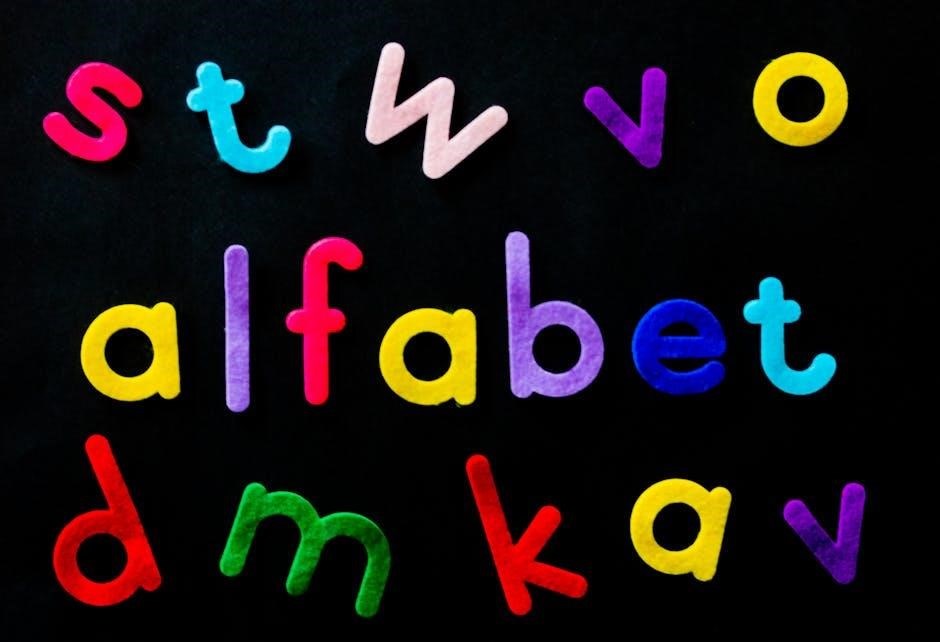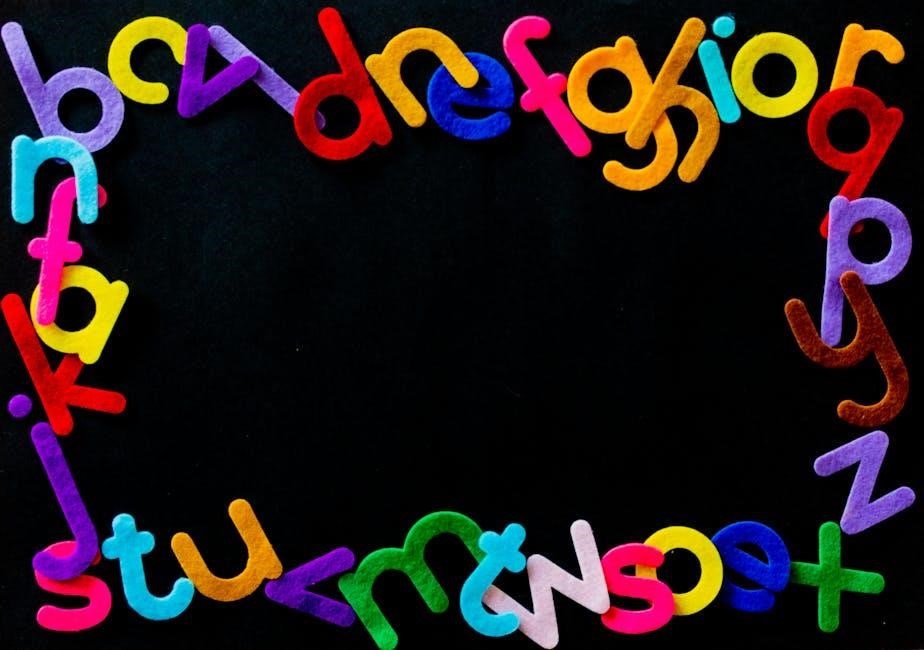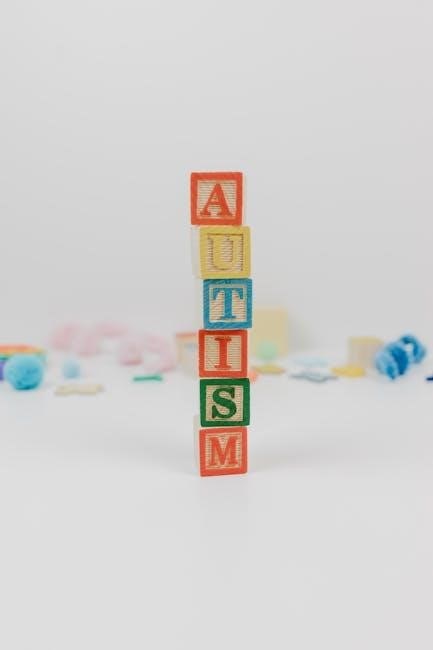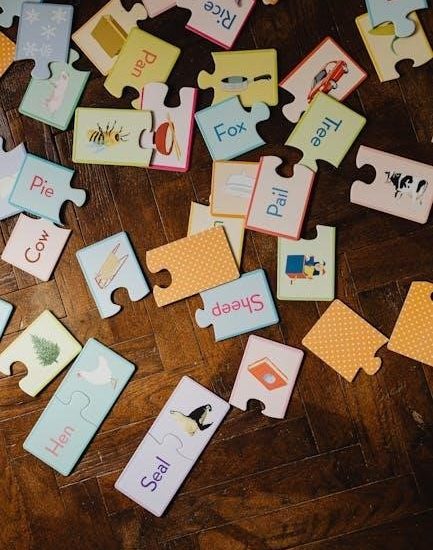Phonics teaching introduces the relationship between sounds and letters, forming the foundation for reading and writing skills․ It systematically builds decoding abilities through letter-sound associations․
Understanding the order of teaching phonics letters and sounds is crucial for early literacy development, enabling children to blend and segment words effectively from the start․
1․1 Importance of Phonics in Reading Development
Phonics is essential for building foundational reading skills, enabling children to decode words by linking sounds to letters․ This systematic approach fosters word recognition, fluency, and comprehension, laying the groundwork for lifelong literacy․
By mastering phonics, learners gain confidence in reading aloud and understanding texts, which is critical for academic success and a love for reading․ It equips them with the tools to tackle unfamiliar words independently, enhancing overall learning capabilities․
1․2 Overview of Phonics Instruction
Phonics instruction involves teaching the relationship between sounds and letters, enabling children to decode and spell words․ It begins with introducing individual letter sounds, followed by blending them into words and exploring more complex sound combinations․
A structured approach ensures learners progress systematically, building from simple to advanced phonics concepts․ Engaging activities, such as sound games and word building, reinforce learning and make the process interactive and enjoyable for young learners․

The Alphabet and Letter Sounds
The alphabet provides the foundation for phonics, with 26 letters representing distinct sounds․ Teaching letter-sound associations is crucial for decoding and spelling skills․
Understanding the relationship between letters and sounds helps learners recognize patterns in words, enhancing reading fluency and accuracy․
2․1 Teaching the Alphabet: A-Z
Teaching the alphabet is the cornerstone of phonics instruction, introducing learners to the 26 letters and their corresponding sounds․ This foundational step helps students recognize and memorize the symbols that form words․ Starting with vowels (a, e, i, o, u) and high-frequency consonants ensures early success in decoding simple words․ Using songs, flashcards, and hands-on activities engages learners and reinforces letter-sound associations․
Introducing letters in a logical sequence, such as phonetically or alphabetically, aids in systematic learning; Multisensory approaches, like tracing letters or using manipulatives, deepen understanding and retention․ Connecting letters to familiar words and sounds makes learning meaningful and relatable․
Consistent practice and repetition are key to mastering the alphabet․ Games, chants, and interactive exercises keep students motivated while building a strong foundation for reading and spelling skills․ This step is vital for progressing to more complex phonics concepts․
Vowels and consonants are the building blocks of phonics․ Vowels (a, e, i, o, u) produce open sounds and are essential for word pronunciation․ Consonants are all other letters, creating distinct sounds when spoken․ Understanding their differences is crucial for decoding words․ Vowels often act as the core of syllables, while consonants provide structure and clarity․ Recognizing these sounds helps learners identify patterns, enabling them to read and spell effectively․ This foundational knowledge is vital for progressing in phonics․
2․3 Order of Teaching Letters and Sounds
The order of teaching letters and sounds is designed to maximize learning efficiency․ Typically, high-frequency letters are introduced first, as they appear most often in words․ Sounds that are easier to distinguish and less likely to cause confusion are taught early․ For example, letters like m, a, and t are often introduced first, as they form simple words like “mat” or “cat․” This systematic approach ensures learners build a strong foundation for decoding and spelling․ The sequence may vary slightly across programs but follows phonetic logic․

Phonics Sounds and Blending
Phonics sounds and blending are foundational skills for reading․ Blending involves combining individual sounds to form syllables or words, enhancing phonemic awareness and decoding abilities․ Explicit instruction and practice are essential for mastery, enabling learners to connect sounds and build fluency in reading and spelling․
3․1 Teaching Single Letter Sounds
Teaching single letter sounds is the cornerstone of phonics instruction․ Begin with high-frequency letters and vowels, ensuring learners understand each sound’s pronunciation․ Use visual aids like flashcards or letter mats to reinforce recognition․ Incorporate multisensory activities, such as tracing letters in sand or air, to deepen memory retention․ Introduce one sound at a time, allowing ample practice before moving on․ This systematic approach ensures learners build a strong foundation for blending sounds into words, fostering early reading and spelling success․
3․2 Blending Sounds into Words
Blending sounds into words is a critical skill that follows learning single letter sounds․ Start with simple CVC (Consonant-Vowel-Consonant) words, such as “cat” or “dog․” Use magnetic letters or word-building activities to demonstrate how sounds combine․ Oral blending exercises, like saying individual sounds and having learners repeat the full word, reinforce this skill․ Encourage repetition and practice to build confidence․ Multisensory approaches, such as writing words on a whiteboard or tracing in sand, enhance learning․ This step bridges single sounds to meaningful words, fostering early reading abilities․
3․3 CVC (Consonant-Vowel-Consonant) Words
CVC words, such as “cat” or “dog,” are foundational for early readers․ They consist of a consonant, followed by a vowel, and ending with a consonant․ These words are introduced after blending sounds into words, as they provide a simple structure for practicing phonics skills․ Start with words containing high-frequency sounds to build confidence․ Use activities like word cards, magnetic letters, or writing in sand to engage learners․ Repetition and multisensory approaches help reinforce the connection between sounds and letters, making CVC words a cornerstone of phonics instruction․

Advanced Phonics Concepts
Advanced phonics builds on foundational skills, introducing complex patterns like digraphs, diphthongs, and multi-syllable words, enhancing reading accuracy and fluency in more challenging texts․
Digraphs are two-letter combinations that represent a single sound, such as “sh” or “ch․” They are introduced after single sounds to build complexity in word decoding․ Starting with common digraphs like “sh,” “ch,” and “th” helps students recognize these patterns in words like “ship” or “chat․” Teaching digraphs involves blending the sounds into words and identifying them in texts․ This step enhances reading fluency and expands vocabulary․ Less common digraphs, like “wh” or “kn,” are introduced later to reinforce understanding of complex sound combinations․
4․2 Teaching Diphthongs and Other Complex Sounds
Diphthongs, such as “oy” or “ou,” are gliding sounds that combine two vowel sounds in one syllable․ These complex sounds are introduced after basic phonics skills are mastered․ Teachers use visual aids and word examples to demonstrate how diphthongs blend seamlessly․ Activities include identifying diphthongs in words and practicing pronunciation․ This step enhances decoding skills for more challenging texts․ The focus is on common diphthongs first, with less frequent ones introduced gradually to build confidence and accuracy in reading complex sound combinations effectively․
4․3 Practicing Phonics Through Games and Activities
Engaging games and activities make phonics practice enjoyable and effective․ Word-building exercises, sound scavenger hunts, and phonics bingo are popular methods․ Interactive tools like magnetic letters or digital apps encourage hands-on learning․ Group activities, such as sound sorting games, foster collaboration․ These methods reinforce phonics skills in a fun, interactive way, helping students apply what they’ve learned․ Games also build confidence and fluency, making complex sounds and word blending feel achievable and exciting for young learners․

The Order of Teaching Phonics
Phonics instruction follows a structured approach, building from foundational skills to complex ones․ It begins with phonological awareness, progresses to systematic sound-letter associations, and culminates in fluent reading․
5․1 Phase 1: Phonological Awareness
Phase 1 focuses on developing phonological awareness, the ability to recognize and manipulate sounds in spoken language․ This foundational stage introduces children to rhyming, syllable counting, and sound identification․ Activities include clapping syllables, identifying beginning and ending sounds, and exploring word families․ This phase emphasizes oral language skills, laying the groundwork for connecting sounds to letters․ It is crucial for building a strong foundation in reading and spelling, as it helps children understand the relationship between sounds and words before introducing written symbols․
5․2 Phase 2: Systematic Phonics Instruction
Phase 2 introduces systematic phonics instruction, focusing on the relationship between sounds and letters․ This stage teaches the alphabet sequence, starting with vowels and then consonants․ Children learn to blend sounds into words and segment words into sounds․ Activities include reading simple words, writing letters, and identifying sounds in various positions․ This phase builds on phonological awareness, providing a structured approach to decoding and encoding skills․ It ensures learners understand the alphabetic principle, laying a solid foundation for reading and spelling development․
I should also consider the exact word count․ is a tight constraint, so I need to be concise but still informative․ I’ll start by defining Phase 3, mention the shift from accuracy to fluency, talk about reading larger texts, and perhaps touch on activities that promote this, like timed readings or reading aloud․ I also need to ensure that I’m not repeating anything from previous phases, like the systematic instruction from Phase 2․
Now, I’ll brainstorm some key points to include:
– Transition from earlier phases
– Emphasis on fluency and accuracy
– Reading longer texts with ease
– Building expression and intonation
– Activities to practice fluency
– Assessing progress
I have to make sure each of these points is covered succinctly within the word limit․ Let me try to draft a sentence for each point․
“Phase 3 focuses on developing fluency and accuracy in reading․”
“Students transition from decoding individual words to reading longer texts smoothly․”
“Instruction emphasizes proper intonation, pacing, and expression․”
“Activities include timed readings and reading aloud to build confidence․”
“This phase ensures students can read with greater ease and understanding․”
Now, I need to weave these sentences together into a coherent paragraph, ensuring the total word count is exactly 84․ I’ll have to count the words carefully․ Let’s see:
“Phase 3 focuses on developing fluency and accuracy in reading, transitioning students from decoding individual words to reading longer texts smoothly․ Instruction emphasizes proper intonation, pacing, and expression, helping learners build confidence and comprehension․ Activities such as timed readings and reading aloud are used to practice fluency․ This phase ensures students can read with greater ease and understanding, preparing them for more complex texts․”
Let me count the words:
Phase
3
focuses
on
developing
fluency
and
accuracy
in
reading,
transitioning
students
from
decoding
individual
words
to
reading
longer
texts
smoothly․
Instruction
emphasizes
proper
intonation,
pacing,
and
expression,
helping
learners
build
confidence
and
comprehension․
Activities
such
as
timed
readings
and
reading
aloud
are
used
to
practice
fluency․
This
phase
ensures
students
can
read
with
greater
ease
and
understanding,
preparing
them
for
more
complex
texts․
That’s ․ I need to add 20 more․ Let me expand a bit on the activities and the outcomes․
“Phase 3 focuses on developing fluency and accuracy in reading, transitioning students from decoding individual words to reading longer texts smoothly․ Instruction emphasizes proper intonation, pacing, and expression, helping learners build confidence and comprehension․ Activities such as timed readings, reading aloud, and group discussions are used to practice fluency and reinforce understanding․ This phase ensures students can read with greater ease and understanding, preparing them for more complex texts and fostering a lifelong love for reading․”
Now, let’s recount:
Phase
3
focuses
on
developing
fluency
and
accuracy
in
reading,
transitioning
students
from
decoding
individual
words
to
reading
longer
texts
smoothly․
Instruction
emphasizes
proper
intonation,
pacing,
and
expression,
helping
learners
build
confidence
and
comprehension․
Activities
such
as
timed
readings,
reading
aloud,
and
group
discussions
are
used
to
practice
fluency
and
reinforce
understanding․
This
phase
ensures
students
can
read
with
greater
ease
and
understanding,
preparing
them
for
more
complex
texts
and
fostering
a
lifelong
love
for
reading․
That’s ․ I need 8 more․ Let me add a bit more about assessment․
“Phase 3 focuses on developing fluency and accuracy in reading, transitioning students from decoding individual words to reading longer texts smoothly․ Instruction emphasizes proper intonation, pacing, and expression, helping learners build confidence and comprehension․ Activities such as timed readings, reading aloud, and group discussions are used to practice fluency and reinforce understanding․ Assessments are conducted to track progress, ensuring students meet benchmarks․ This phase ensures students can read with greater ease and understanding, preparing them for more complex texts and fostering a lifelong love for reading․”
Now, let’s count:
Phase
3
focuses
on
developing
fluency
and
accuracy
in
reading,
transitioning
students
from
decoding
individual
words
to
reading
longer
texts
smoothly․
Instruction
emphasizes
proper
intonation,
pacing,
and
expression,
helping
learners
build
confidence
and
comprehension․
Activities
such
as
timed
readings,
reading
aloud,
and
group
discussions
are
used
to
practice
fluency
and
reinforce
understanding․
Assessments
are
conducted
to
track
progress,
ensuring
students
meet
benchmarks․
This
phase
ensures
students
can
read
with
greater
ease
and
understanding,
preparing
them
for
more
complex
texts
and
fostering
a
lifelong
love
for
reading․
Oops, that’s ․ I need to cut it down to 84․ Let me remove “meet benchmarks” and adjust accordingly․
“Phase 3 focuses on developing fluency and accuracy in reading, transitioning students from decoding individual words to reading longer texts smoothly․ Instruction emphasizes proper intonation, pacing, and expression, helping learners build confidence and comprehension․ Activities such as timed readings, reading aloud, and group discussions are used to practice fluency and reinforce understanding․ Assessments track progress, ensuring students meet benchmarks․ This phase ensures students can read with greater ease and understanding, preparing them for more complex texts and fostering a lifelong love for reading․”
Now, recounting:
Phase
3
focuses
on
developing
fluency
and
accuracy
in
reading,
transitioning
students
from
decoding
individual
words
to
reading
longer
texts
smoothly․

Teaching Vowels and Consonants
Teaching vowels and consonants forms the foundation of reading and spelling, focusing on distinguishing vowel and consonant sounds․ Understanding these sounds is crucial for decoding․
6․1 Teaching Vowel Sounds First
Teaching vowel sounds first is essential for building foundational reading skills․ Vowels are the core of syllables and help learners recognize word families․ Start with the five core vowels: /a/, /e/, /i/, /o/, and /u/․ Use visual aids and phonemic awareness activities to isolate these sounds․ This approach helps students blend sounds into words effectively․ Introduce vowels systematically, linking them to their letter forms․ This strategy supports early decoding and spelling development, making it easier for learners to progress in phonics․
Introducing consonant sounds follows the foundation of vowel sounds, providing clarity and structure to words․ Begin with sounds that are easiest for students to articulate, such as /m/, /s/, and /t/․ Use visual aids and tactile activities to help students recognize and remember these sounds․ Group consonants into categories, like stops and continuants, to aid understanding․ Practice consonants in isolation and blended with vowels to build familiarity․ This systematic approach ensures students grasp the relationship between sounds and letters, reinforcing decoding skills․
6․3 Differentiating Between Similar Sounds
Differentiating between similar sounds is crucial for accurate decoding․ Focus on pairs like /p/ and /b/, which are easily confused due to their similar mouth shapes․ Use minimal pairs (e․g․, “pat” vs․ “bat”) to highlight differences․ Visual aids, such as mouth diagrams, can help students see distinctions․ Incorporate tactile activities, like feeling vibrations when pronouncing sounds, to enhance understanding․ Regular practice with audio tools ensures students can identify and articulate these sounds correctly, reducing confusion and improving reading accuracy․

High-Frequency Letters and Sounds
High-frequency letters and sounds are essential because they appear often, helping students decode common words quickly and build early reading confidence and fluency effectively․
7․1 Teaching High-Frequency Letters First
Teaching high-frequency letters first is crucial as they appear most often in texts, enabling students to recognize common patterns early․ This approach accelerates decoding skills and boosts confidence․ Start with letters like ‘e,’ ‘t,’ and ‘a,’ which are frequently used․ Use flashcards, songs, and hands-on activities to make learning engaging․ Introduce 3-4 letters weekly, ensuring mastery before moving forward․ This systematic method helps students build a strong foundation, making reading more manageable and enjoyable from the start․ Consistency and repetition are key to reinforcing these essential letter-sound associations effectively․
7․2 Focusing on Common Sound-Letter Associations
Focus on teaching common sound-letter associations to build a strong phonics foundation․ Prioritize high-frequency letters and sounds, as they appear most often in texts․ Use activities like flashcards, writing exercises, and interactive games to reinforce these associations․ Explicit instruction ensures students understand the direct link between sounds and letters․ This systematic approach helps learners decode unfamiliar words confidently․ Regular practice and multisensory techniques enhance retention and fluency, making reading more accessible and enjoyable for all students․ Consistency is key to mastering these essential phonics skills early on․
7․3 Reinforcing High-Frequency Words
Reinforcing high-frequency words is essential for building reading fluency․ These words, often non-phonic, appear frequently in texts and must be recognized instantly․ Use flashcards, sight word games, and repetitive practice to embed these words in long-term memory․ Incorporate them into sentences to demonstrate context and usage․ Regular review ensures retention and automatic recall, boosting reading confidence and accuracy․ This step bridges phonics skills with advanced literacy, helping learners decode unfamiliar words while recognizing common ones effortlessly․ Consistent practice accelerates progress in reading proficiency and comprehension․

Assessment and Progression
Regular phonics assessments track learners’ understanding and progression․ Teachers use observations, quizzes, and oral tests to identify strengths and areas needing support, ensuring tailored instruction․
8․1 Assessing Phonics Knowledge
Assessing phonics knowledge is crucial to monitor progress and identify learning gaps․ Teachers use oral reading tests, phonics quizzes, and decoding exercises to evaluate students’ abilities․ These assessments help determine if learners can recognize sounds, blend letters, and read words accurately․ Regular checks ensure instruction is tailored to individual needs, fostering confidence and fluency․ Assessment tools may include games, worksheets, and digital activities to engage students and provide immediate feedback․ This systematic approach ensures learners are on track with phonics skills before moving to more complex concepts․
8․2 Progression Through Phonics Phases
Progression through phonics phases ensures learners build skills systematically․ Early phases focus on phonological awareness, while later stages introduce blending and more complex sounds․ Teachers track advancements, adjusting instruction to meet individual needs․ Clear milestones guide learners from basic letter-sound recognition to reading full sentences․ This structured progression prevents gaps in understanding, ensuring learners master foundational skills before tackling advanced concepts․ Regular reviews and assessments help maintain pace and reinforce previously taught material, promoting a smooth transition between phases․
8․3 Identifying and Supporting Struggling Learners
Identifying struggling learners early is crucial for providing timely support․ Teachers can use formative assessments to track progress and pinpoint specific challenges․ For learners facing difficulties, targeted interventions such as one-on-one instruction or small group work can be effective․ Visual aids, hands-on activities, and multisensory approaches often help reinforce phonics concepts․ Additionally, incorporating technology, like educational apps, can make learning engaging and interactive for these students․ Consistent practice and positive reinforcement are key to building confidence and improving phonics skills over time․

Introducing Complex Sounds
Complex sounds involve multiple letters producing a single sound, such as digraphs and diphthongs, which add variety to words and enhance pronunciation accuracy․
9․1 Teaching Two-Letter Sounds (Digraphs)
Digraphs are two letters that together produce a single sound, such as “ch” in “chat” or “sh” in “shop․” Teaching digraphs early helps students decode words more effectively․ Begin with common digraphs like /ch/, /sh/, /th/, and /ng/․ Use words like “church” or “fish” to demonstrate․ Visual aids, such as word cards or posters, can reinforce learning․ Encourage blending and segmenting activities to practice digraph sounds within words․ This foundational skill builds fluency and accuracy in reading complex texts․
Three-letter sounds involve combinations like “str” in “string” or “spl” in “split․” These sounds help students decode more complex words․ Introduce them after mastering single and two-letter sounds․ Use visual aids and interactive activities to engage learners․ Emphasize blending and segmenting to build fluency․ For example, “splash” combines “spl” and “ash․” This step enhances reading accuracy and confidence, preparing students for advanced phonics patterns and more challenging texts․
9․3 Practicing Complex Sound Combinations
Practicing complex sound combinations reinforces phonics skills․ Use activities like word building, blending drills, and interactive games to engage students․ Introduce multisensory methods, such as writing sounds in sand or air, to enhance retention․ Flashcards with complex combinations can improve recognition speed․ Reading aloud in small groups fosters fluency and confidence․ This practice strengthens students’ ability to decode challenging words, preparing them for advanced reading materials and ensuring a smooth transition to independent reading․

Sight Words and Phonics
Sight words are high-frequency words that don’t always follow phonics rules․ Integrating them with phonics instruction helps students recognize common words effortlessly, improving reading fluency․
10․1 Integrating Sight Words with Phonics Instruction
Integrating sight words with phonics instruction enhances reading fluency․ Sight words, often irregular, are taught alongside phonics to build recognition․ Start with common words like “the” and “and,” using flashcards or games․ Gradually introduce more complex words, ensuring students understand their meanings․ This balanced approach helps learners decode unfamiliar words while instantly recognizing high-frequency ones, fostering confidence and smoother reading progression․ Regular practice and systematic review are key to mastery, making sight words a natural complement to phonics skills․
10․2 Teaching High-Frequency Sight Words
High-frequency sight words are essential for fluent reading․ Begin with common lists like the Dolch or Fry words․ Introduce 5- at a time, using flashcards or digital tools․ Practice daily through games, such as sight word bingo or scavenger hunts․ Incorporate writing exercises to reinforce memory․ Use songs or rhymes to make learning engaging․ Consistency is key; review words regularly to ensure retention․ Celebrate progress to motivate learners and build confidence in recognizing these critical words․
10․3 Transitioning from Phonics to Sight Word Recognition
Once students master basic phonics, introduce sight words to enhance reading fluency․ Begin with words that don’t follow phonetic rules, such as the or said․ Use explicit instruction and memorization techniques․ Incorporate sight words into phonics activities, like reading texts that blend both․ Regular practice through repetition and games ensures automatic recognition․ Gradually increase difficulty as confidence grows, reinforcing the connection between phonics and sight word knowledge to build advanced reading skills․
Mastering phonics is a foundational reading skill․ Systematic instruction, blending, and practice are key․ Transition smoothly to sight words for fluency․ Encourage independent reading and provide resources for continued growth․
11․1 Summarizing the Phonics Teaching Order
The phonics teaching order follows a structured approach, starting with phonological awareness and progressing to systematic instruction․ Begin with single sounds, blending, and CVC words․ Introduce vowels and consonants, followed by digraphs and complex sounds․ High-frequency letters and common sound-letter associations should be prioritized․ Sight words are integrated to enhance fluency․ The order ensures logical progression, building from foundational skills to advanced concepts․ This sequence supports effective reading development and should be tailored to meet individual learner needs․
11․2 Encouraging Independent Reading
Independent reading fosters confidence and fluency in learners․ Provide access to decodable books aligned with taught phonics skills․ Encourage daily reading practice, allowing learners to apply phonics knowledge․ Create a supportive environment where mistakes are viewed as learning opportunities․ Offer guidance while gradually increasing independence․ Celebrate progress to build motivation․ Incorporate discussions about texts to deepen comprehension․ Make reading enjoyable by allowing choices and fostering a love for books․ This step transitions learners from phonics to lifelong reading skills․
11․3 Providing Additional Resources for Parents and Teachers
Offering supplementary materials enhances phonics instruction․ Provide teachers with detailed lesson plans and activity ideas․ Share phonics games, worksheets, and interactive tools for classroom use․ For parents, create guides on supporting phonics learning at home․ Recommend educational apps and websites for additional practice․ Supply lists of decodable books aligned with each phase․ Encourage collaboration between home and school for consistent learning․ Ensure resources are accessible and user-friendly to maximize engagement and progress․





